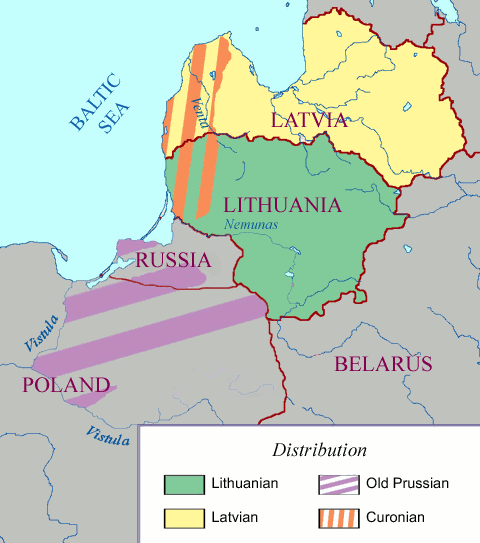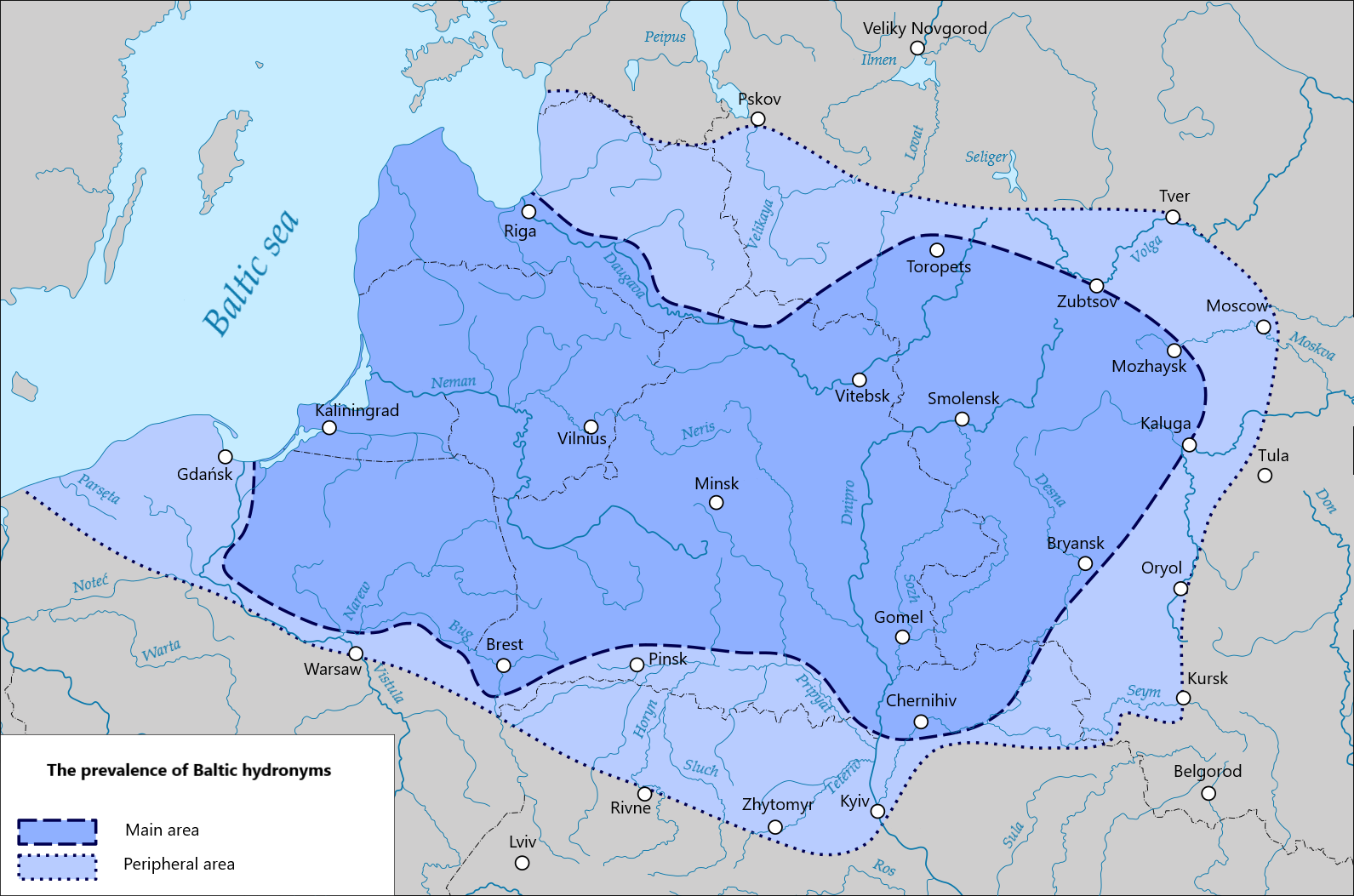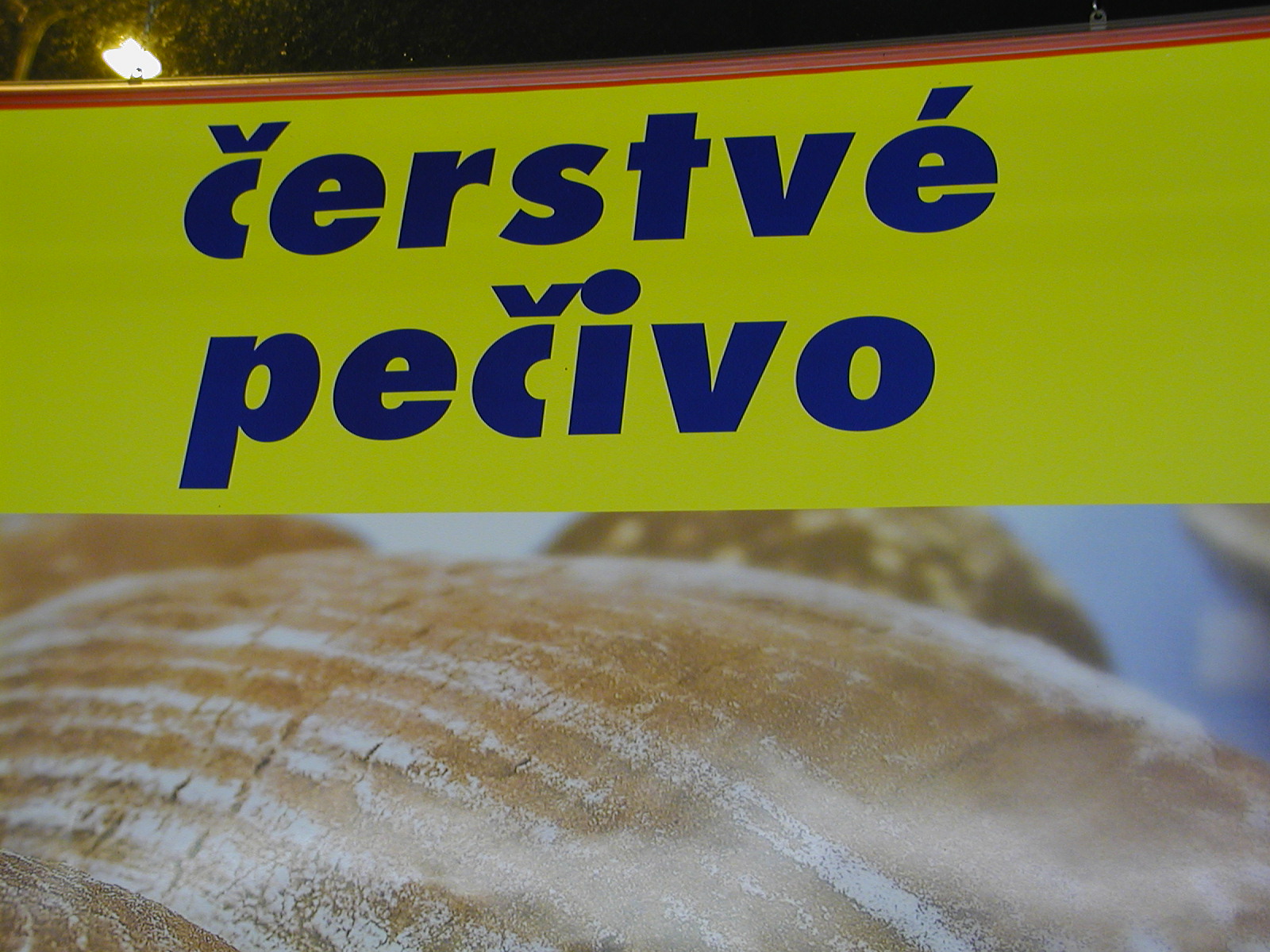|
Baltic Language
The Baltic languages are a branch of the Indo-European language family spoken natively by a population of about 4.5 million people mainly in areas extending east and southeast of the Baltic Sea in Northern Europe. Together with the Slavic languages, they form the Balto-Slavic branch of the Indo-European family. Scholars usually regard them as a single subgroup divided into two branches: Western Baltic (containing only extinct languages) and Eastern Baltic (containing at least two living languages, Lithuanian, Latvian, and by some counts including Latgalian and Samogitian as separate languages rather than dialects of the two aforementioned languages). The range of the Eastern Baltic linguistic influence once possibly reached as far as the Ural Mountains, but this hypothesis has been questioned. Old Prussian, a Western Baltic language that became extinct in the 18th century, has possibly retained the greatest number of properties from Proto-Baltic. Although related, Lithu ... [...More Info...] [...Related Items...] OR: [Wikipedia] [Google] [Baidu] |
Proto-Baltic
Proto-Baltic (PB, PBl, Common Baltic) is the unattested, reconstructed ancestral proto-language of all Baltic languages. It is not attested in writing, but has been partly reconstructed through the comparative method by gathering the collected data on attested Baltic and other Indo-European languages. It represents the common Baltic speech that approximately was spoken between the 3rd millennium BC and ca. 5th century BC, after which it began dividing into Western and Eastern Baltic languages. Proto-Baltic is thought to have been a fusional language and is associated with the Corded Ware and Trzciniec cultures. Baltic languages share some common features with Slavic languages, suggesting the possibility of an earlier linguistic unity in development. Generally, Proto-Baltic had a SOV word order. Proto-Baltic is said to have possessed certain unique traits, such as free accentuation with two pitch accents, turning short Proto-Indo-European vowels ''*o'', ''*a'' into ''*a'', retain ... [...More Info...] [...Related Items...] OR: [Wikipedia] [Google] [Baidu] |
Proto-Baltic Language
Proto-Baltic (PB, PBl, Common Baltic) is the unattested, reconstructed ancestral proto-language of all Baltic languages. It is not attested in writing, but has been partly reconstructed through the comparative method by gathering the collected data on attested Baltic and other Indo-European languages. It represents the common Baltic speech that approximately was spoken between the 3rd millennium BC and ca. 5th century BC, after which it began dividing into Western and Eastern Baltic languages. Proto-Baltic is thought to have been a fusional language and is associated with the Corded Ware and Trzciniec cultures. Baltic languages share some common features with Slavic languages, suggesting the possibility of an earlier linguistic unity in development. Generally, Proto-Baltic had a SOV word order. Proto-Baltic is said to have possessed certain unique traits, such as free accentuation with two pitch accents, turning short Proto-Indo-European vowels ''*o'', ''*a'' into ''*a'', retain ... [...More Info...] [...Related Items...] OR: [Wikipedia] [Google] [Baidu] |
Lithuanian Language
Lithuanian ( ) is an Eastern Baltic language belonging to the Baltic branch of the Indo-European language family. It is the official language of Lithuania and one of the official languages of the European Union. There are about 2.8 million native Lithuanian speakers in Lithuania and about 200,000 speakers elsewhere. Lithuanian is closely related to the neighbouring Latvian language. It is written in a Latin script. It is said to be the most conservative of the existing Indo-European languages, retaining features of the Proto-Indo-European language that had disappeared through development from other descendant languages. History Among Indo-European languages, Lithuanian is conservative in some aspects of its grammar and phonology, retaining archaic features otherwise found only in ancient languages such as Sanskrit (particularly its early form, Vedic Sanskrit) or Ancient Greek. For this reason, it is an important source for the reconstruction of the Proto-Indo-Euro ... [...More Info...] [...Related Items...] OR: [Wikipedia] [Google] [Baidu] |
Balts
The Balts or Baltic peoples ( lt, baltai, lv, balti) are an ethno-linguistic group of peoples who speak the Baltic languages of the Balto-Slavic branch of the Indo-European languages. One of the features of Baltic languages is the number of conservative or archaic features retained. Among the Baltic peoples are modern-day Lithuanians and Latvians (including Latgalians) — all Eastern Balts — as well as the Old Prussians, Yotvingians and Galindians — the Western Balts — whose languages and cultures are now extinct. Etymology Medieval German chronicler Adam of Bremen in the latter part of the 11th century AD was the first writer to use the term "Baltic" in reference to the sea of that name.Bojtár page 9. Before him various ancient places names, such as Balcia, were used in reference to a supposed island in the Baltic Sea. Adam, a speaker of German, connected ''Balt-'' with ''belt'', a word with which he was familiar. In Germanic languages there was some form of t ... [...More Info...] [...Related Items...] OR: [Wikipedia] [Google] [Baidu] |
Samogitian Language
Samogitian ( sgs, žemaitiu kalba, link=no or sometimes ', ''žemaitiu šnekta'' or '; lt, žemaičių tarmė, žemaičių kalba) is an Eastern Baltic language spoken mostly in Samogitia (in the western part of Lithuania). In Lithuania, it is mostly treated as a dialect of Lithuanian, but it is also considered as a separate language by some linguists inside and outside of Lithuania. Its recognition as a distinct language is increasing in recent years, and attempts have been made to standardize it. The Samogitian language should not be confused with the interdialect of the Lithuanian language as spoken in the Duchy of Samogitia before Lithuanian became a written language, which later developed into one of the two variants of written Lithuanian used in the Grand Duchy of Lithuania based on the so-called middle dialect of the Kėdainiai region. This was called the Samogitian (Žemaitian) language; the term "Lithuanian language" then referred to the other variant, which had bee ... [...More Info...] [...Related Items...] OR: [Wikipedia] [Google] [Baidu] |
Semigallian Language
Semigallian, or Zemgalian, was an Eastern Baltic language of the Baltic language sub-family of the Indo-European languages. History It was spoken in the northern part of Lithuania and southern regions of Latvia in what is known as Semigallia. It is thought that it was extinct by the 16th century, with the assimilation by the Latvians Latvians ( lv, latvieši) are a Baltic ethnic group and nation native to Latvia and the immediate geographical region, the Baltics. They are occasionally also referred to as Letts, especially in older bibliography. Latvians share a common Latvi .... Semigallian is known only from references to it in documents and texts from before the 16th century. Phonology Semigallian shares some phonological similarities to Curonian and, to a lesser extent, Latvian. The Common Baltic , consonants became , in their soft varieties in Semigalian. All long vowels and diphthongs at the end of the word in Common Baltic were reduced to simple short vowels ... [...More Info...] [...Related Items...] OR: [Wikipedia] [Google] [Baidu] |
Selonian Language
Selonian was an Eastern Baltic language, which was spoken by the Eastern Baltic tribe of the Selonians, who until the 15th century lived in Selonia, a territory in southeastern Latvia and northeastern Lithuania. History During the 13th–15th centuries, the Selonians lost their language after being assimilated by the Lithuanians. Traces of the Selonian language can still be found in the territories the Selonians inhabited, especially in the accent and phonetics of the so-called Selonian dialect of the Latvian language. There are some traces of the Selonian language in the northeastern sub-dialects of the Aukštaitian dialect of the Lithuanian language, mostly in the lexicon. Classification It is considered that the Selonian language retained the Proto-Baltic phonemes *an, *en, *in, *un like the Lithuanian language, but like the Latvian language Latvian ( ), also known as Lettish, is an Eastern Baltic language belonging to the Baltic branch of the Indo-European langua ... [...More Info...] [...Related Items...] OR: [Wikipedia] [Google] [Baidu] |
Glottolog
''Glottolog'' is a bibliographic database of the world's lesser-known languages, developed and maintained first at the Max Planck Institute for Evolutionary Anthropology in Leipzig, Germany (between 2015 and 2020 at the Max Planck Institute for the Science of Human History in Jena, Germany). Its main curators include Harald Hammarström and Martin Haspelmath. Overview Sebastian Nordhoff and Harald Hammarström created the Glottolog/Langdoc project in 2011. The creation of ''Glottolog'' was partly motivated by the lack of a comprehensive language bibliography, especially in ''Ethnologue''. Glottolog provides a catalogue of the world's languages and language families and a bibliography on the world's less-spoken languages. It differs from the similar catalogue '' Ethnologue'' in several respects: * It tries to accept only those languages that the editors have been able to confirm both exist and are distinct. Varieties that have not been confirmed, but are inherited from anothe ... [...More Info...] [...Related Items...] OR: [Wikipedia] [Google] [Baidu] |
Loanwords
A loanword (also loan word or loan-word) is a word at least partly assimilated from one language (the donor language) into another language. This is in contrast to cognates, which are words in two or more languages that are similar because they share an etymological origin, and calques, which involve translation. Loanwords from languages with different scripts are usually transliterated (between scripts), but they are not translated. Additionally, loanwords may be adapted to phonology, phonotactics, orthography, and morphology of the target language. When a loanword is fully adapted to the rules of the target language, it is distinguished from native words of the target language only by its origin. However, often the adaptation is incomplete, so loanwords may conserve specific features distinguishing them from native words of the target language: loaned phonemes and sound combinations, partial or total conserving of the original spelling, foreign plural or case forms or indeclin ... [...More Info...] [...Related Items...] OR: [Wikipedia] [Google] [Baidu] |
False Friend
In linguistics, a false friend is either of two words in different languages that look or sound similar, but differ significantly in meaning. Examples include English ''embarrassed'' and Spanish ''embarazada'' 'pregnant'; English ''parents'' versus Portuguese ''parentes'' and Italian ''parenti'' (both meaning 'relatives'); English ''demand'' and French ''demander'' 'ask'; and English ''gift'', German ''Gift'' 'poison', and Norwegian ''gift'' 'married'. The term was introduced by a French book, ''Les faux amis: ou, Les trahisons du vocabulaire anglais'' (''False friends, or, the betrayals of English vocabulary''), published in 1928. As well as producing completely false friends, the use of loanwords often results in the use of a word in a restricted context, which may then develop new meanings not found in the original language. For example, ''angst'' means 'fear' in a general sense (as well as 'anxiety') in German, but when it was borrowed into English in the context of psyc ... [...More Info...] [...Related Items...] OR: [Wikipedia] [Google] [Baidu] |
Mutual Intelligibility
In linguistics, mutual intelligibility is a relationship between languages or dialects in which speakers of different but related varieties can readily understand each other without prior familiarity or special effort. It is sometimes used as an important criterion for distinguishing languages from dialects, although sociolinguistic factors are often also used. Intelligibility between languages can be asymmetric, with speakers of one understanding more of the other than speakers of the other understanding the first. When it is relatively symmetric, it is characterized as "mutual". It exists in differing degrees among many related or geographically proximate languages of the world, often in the context of a dialect continuum. Intelligibility Factors An individual's achievement of moderate proficiency or understanding in a language (called L2) other than their first language (L1) typically requires considerable time and effort through study and practical application if the two l ... [...More Info...] [...Related Items...] OR: [Wikipedia] [Google] [Baidu] |
Linguistic Conservatism
In linguistics, a conservative form, variety, or feature of a language is one that has changed relatively little across the language's history, or which is relatively resistant to change. It is the opposite of innovative, innovating, or advanced forms, varieties, or features, which have undergone relatively larger or more recent changes. On the other hand, an ''archaic'' form is chronologically old and rarely used in the modern language, and an ''obsolete'' form has fallen out of use altogether. A conservative linguistic form, such as a word or sound feature, is one that remains closer to an older form from which it evolved, relative to cognate forms from the same source. For example, the Spanish word ''caro'' and the French word ''cher'' both evolved from the Latin word ''cārum''. The Spanish word, which is more similar to the common ancestor, is more conservative than its French cognate. A language or language variety is said to be conservative if it has fewer innovations (in ... [...More Info...] [...Related Items...] OR: [Wikipedia] [Google] [Baidu] |



